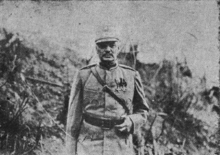| Romanian military intervention in Bessarabia | |||||||||
|---|---|---|---|---|---|---|---|---|---|
| Part of the Allied intervention in the Russian Civil War and WWI | |||||||||
 Romanian general Ernest Broșteanu in Bessarabia during 1918 | |||||||||
| |||||||||
| Belligerents | |||||||||
|
|
| ||||||||
| Commanders and leaders | |||||||||
|
|
| ||||||||
| Strength | |||||||||
|
800–1,000 Transylvanian volunteers c. 50,000 Romanian regular troops Danube Flotilla |
c. 6,000 in Chișinău over 1,000 in Bălți c. 1,000 in Vâlcov c. 2,000 in Akkerman 3 infantry regiments 1 infantry battalion 2 hussar regiments 2 cavalry regiments 2 cavalry squadrons 1 railroad battalion 1 artillery brigade 1 machine-gun company 1 automobile company several Red Guards detachments 500 Romanian volunteers several military vessels | ||||||||
| Casualties and losses | |||||||||
|
c. 150 killed c. 2,100 captured 2 floating batteries captured | >1,500–2,000 killed | ||||||||
The Romanian military intervention in Bessarabia took place between 19 January and 8 March (Old Style [O.S.] 5 January – 23 February) 1918, as part of the broader Allied intervention in the Russian Civil War. It pitted the Kingdom of Romania, Russian Republic, Ukrainian People's Republic and anti-Bolshevik factions of the Moldavian Democratic Republic on one side, against the Bolshevik controlled Rumcherod and Odessa Soviet Republic, as well as pro-Bolshevik factions within the Moldavian DR. The intervention began when the Romanian army and its allies crossed into Bessarabia and launched an attack on Chișinău and Ungheni, capturing the latter.
On 19 January, the Bolshevik Frontotdel took hold of Chișinău, only to lose it to a second Romanian offensive on 26 January. On 29 January, Romanian troops besieged Bender; after much bitter fighting the defenders retreated from the city on 2 February. In northern Bessarabia, Romanian troops seized Bălți on 5 February. On 14 February, Vladimir Lenin appointed Mikhail Muravyov as the commander of the Bessarabia and Transnistria Front, reinforcing it with 3,000 soldiers. Muravyov went on a counter-offensive, achieving a number of victories, however his gains were erased when the Central Powers launched a large scale offensive against the Bolsheviks. In the south, Bolshevik sailors continued to control parts of the Budjak until early March, before retreating to Odessa.
Romania used the opportunity to break armistice negotiations with the Bolsheviks and occupy the last Bessarabian territories not under its control. On 6 February, Sfatul Țării, the Moldavian Democratic Republic's parliament, declared the country's independence. On 9 April 1918, the Moldavian Democratic Republic united with Romania.